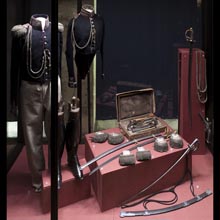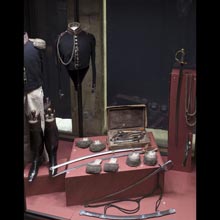

1. Jan Weysenhoff’s division general’s uniform
Poland, 1825-1830
Deposit of the Jagiellonian University Museum
2. Pair of cavalry aide-de-camp’s uniform high-boots with boot-trees
Poland, signed: „Nr.1365 Walter et Heyn w Warszawie ul. Senatorska Nr.168”,
1815-1831
Gift of Leon and Stanisław Czajkowscy, 1911
3. Cavalry aide-de-camp’s long-jacket
Poland, 1822-1831
Gift of Hugon Wróblewski, 1892
4. Division general’s epaulettes
Poland, 1815-1831
5. Cased pair of percussion pistols, a gift from general Lafayette for general Józef Chłopicki in 1830
Paris, gunsmith Le Page, about 1830
Rifled, calibre: 13 mm
6. Jan Zygmunt Skrzynecki’s sabre with sheath
France, after 1831
Gift of B. Starzeńska from the former collection of Bronisław Starzeński, 1909
The sabre comes from the time of Jan Skrzynecki service as a Division General in the Belgian army.
Inscription on the blade in French (translated): „Tribute Given For Brave General And Chief Jean Skrzynecki As The Proof Of The Highest Admiration For His Courage And Constancy. Heroic And Noble Sacrifice Of The Immortal Polish Nation And Its Distinguished General, From Sir Henry"
7. General Jan Skrzynecki’s commander-in-chief’s epaulettes
Poland, 1831
Gift of Bronisław Starzeński, 1909
8. General Jan Skrzynecki’s commander-in-chief’s epaulettes
Poland, 1831
Gift of Bronisław Starzeński, 1909
9. General Jan Skrzynecki’s cavalry sabre with sheath
Belgium, after 1831
Gift of Bronisław Starzeński, 1909
10. Staff officer’s aiguillettes
Poland, 1815-1831
Gift of Henryk Stecki, 1911
11. General Jan Skrzynecki’s flint-lock pistol
Germany, signed „BOCKER & HILGER A REMSCHEID”, about 1820
Rifled, calibre: 14 mm
12. General Jan Skrzynecki’s polish „batorówka” sabre with sheath
Poland, blade from the 18th century, fittings from the 19th century
Gift of Bronisław Starzeński, 1909
One side of the blade is encrusted with a gold inscription: „Naczelnemu Wodzowi Janowi Skrzyneckiemu Legija Nadwiślańska" (To Commander-in-Chief Jan Skrzynecki, from the Vistula Legion)
exposition: Gallery „Arms and Uniforms in Poland",
The Main Building, 1, 3 Maja Av.
key: Military and civilian uniform <<<
The collection of 18th- to 20th-century uniforms and accessories belonging to the National Museum in Krakow, the second largest in size and scope in Poland, contains unique examples of Polish uniforms from the 18th and 19th centuries. The oldest uniform element from the Polish military in the collection is the grenadier cap from the Lithuanian Foot Guards Regiment from 1732. The museum is in also in possession of the only preserved General’s uniform from the National Cavalry from the 18th century, which belonged to Benedict Kołyszka. Uniforms of the nineteenth century are represented by the army general’s uniform of Franciszek Paszkowski, who was also the owner of Varsovian Duke Fredyryk August’s chamberlain’s uniform. No less interesting is the officer’s uniform of the light cavalry of the Imperial Guards of Emperor Napoleon I, as is the officer’s uniform from the Second Uhlan Regiment of the Congress Kingdom of Poland. Also from that period are a large number of uniform jackets, caps and flat caps, epaulettes, gorgets, ammunition pouches, and other items. A unique item which attracts little attention is a pair of high boots from the Congress Kingdom period with shoe trees belonging to the unform of an cavalry adjutant general and a pair of epualettes from 1831 from a horse cavalry officer’s uniform belonging to Konstanty Ordon, the hero imortalised in Adam Mickiewicz’s poem Ordon’s Redoubt (Reduta Ordona).
In addition to Polish uniforms, the collection contains nineteenth-century military uniforms and effects from other European countries: France, Prussia, Russia, Austria and the Vatican. Standing out among them are a complete French female sutler uniform from the Third Empire period and a dolman belonging to Henryk Dembiński, commander-in-chief of the Hungarian uprising in 1849.
A separate group is made up of Polish and European civilian uniforms with unique dress coats of the Senators of the Congress Kingdom of Poland, the authorities of the Free City of Krakow, the diplomatic service of Austria and Poland, and the uniform of a Knight of Malta from the 1920s.
The twentieth-century uniform collection is somewhat more modest, but also contains some very rare items, such as hats and jackets of the Uhlan regiments of the Polish Legions, elements of uniforms from the Polish-Bolshevik war, the two decades of the interwar period, and a collection of designs for military ranks for collars and epaulettes for the First and Second Brigades of the Polish Legions and the Armed Forces of the Polish Republic from 1914-1917. This is the only set of its kind preserved in a Polish museum, constituting an immeasurably important historical source regarding those units, received as a gift from the Supreme National Committee in 1920. The collection is continued with uniforms from the period of the Second World War and the post-war period, as well as post-war uniforms used until the end of the twentieth century.
Piotr Wilkosz












